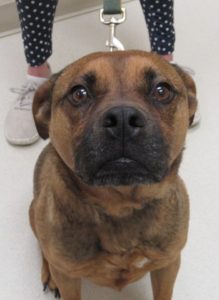
This month we are bringing attention to a common issue we see in veterinary medicine. Pets can hide their illness, even when they are very sick. When that happens to our pet, we are left wondering ‘how come I didn’t know’ or ‘what could I have done differently’. We frequently feel guilty or second guess our past decisions. The message for us as pet owners is really more about understanding a bit about why animals hide their symptoms, why we might not recognize them when they begin, and what we can do to try and avoid these situations.
To illustrate this, we are honoring a friendly and happy Shepherd mix dog named Buddy. He is just over five years old and shares his house with another canine companion. Buddy and his family recently moved from Maryland to the Seattle area and after getting settled, his owners scheduled visits for both dogs at Hawthorne Hills Veterinary Hospital to get acquainted and to update vaccinations. To the owners, Buddy and Leila seemed to be healthy other than both had developed some dental disease. The owners noticed that Buddy in particular had fairly smelly breath which is not atypical once there is an accumulation of tartar on the teeth.
At the initial visit both dogs were outwardly normal. They were wagging their tails, taking treats, asking for attention – all typical behaviors that we equate with dogs feeling relaxed and healthy. However, Dr. Eskesen noticed a very strong odor of urine emanating from Buddy’s mouth. This was not the usual ‘I haven’t brushed my teeth in a while’ smell, but a different more concentrated urine smell. These subtle changes are the things that veterinarians are trained to pick up on. We look for small clues to help us see beyond how a dog or cat is acting. Many times, these variations are signposts to an underlying problem.
In Buddy’s case, Dr. Eskesen was concerned about more than just dental disease. Other conditions such as gastric reflux, intestinal disease, urinary tract infections, kidney disease and diabetes can all alter a patient’s breath. Blood and urine samples were submitted to the lab to help with a diagnosis.
The blood results indicated severely elevated kidney blood values so Buddy was admitted to Animal Medical Center in Seattle for intravenous fluid therapy and further diagnostics. Initially there was some concern that Buddy could have Leptospirosis and he tested positive for Lyme Disease but he had lived in Maryland where Lyme Disease is more common. Ultimately, an abdominal ultrasound revealed the true cause of Buddy’s elevated kidney values: Renal Dysplasia. This is a genetic condition where the kidney tissue fails to develop properly. It is possible that the condition might have been discovered earlier with blood or urine testing, but the kidneys are amazingly efficient so it is common that signs of the disease don’t appear for quite some time, often years. And, as in Buddy’s case, while the disease was quite advanced, he really wasn’t showing overt symptoms.
The general role of the kidney is to filter out metabolic wastes, conserve water, and eliminate the waste as urine. When the kidneys fail, the opposite happens – wastes build up and water is lost. This contributes to dehydration, nausea, and eventual damage to all of the body’s tissues. Treatment is focused on supporting the remaining kidney tissue and helping the body eliminate the metabolic wastes. Buddy is now on Hill’s canine k/d®, a renal specific food to help support his kidney function, Cerenia® to control nausea a common side-effect of kidney disease, a phosphate binder to limit the amount of phosphorus in his blood, and subcutaneous (SQ) fluids administered daily at home.
Once therapy was started, Buddy’s owners noticed a significant improvement in how he was eating and feeling. Sometimes, we find out our pet wasn’t feeling all that great, after treatment is started and we see how much better they are when the underlying problem is being addressed.
Buddy’s owners also met with Dr. Tanya Donovan (internal medicine specialist) at Animal Medical Center to discuss the long-term options and treatment plans. Buddy was determined to be an excellent candidate for Stem Cell Therapy and he has already received his treatment. We are hopeful that this will further improve Buddy’s odds of living longer with his kidney disease.
Why don’t pets tell us when they are ill?
- As pet owners, we aren’t very skilled at recognizing body language from dogs and cats. We see behaviors and yet we make assumptions that may not be accurate.
- Further, because animals don’t verbalize in words we understand, we may miss the clues they do give or interpret them incorrectly. As an example, a pet walking away from a food dish could mean:
- I’m really not hungry cause I already ate too much earlier
- Someone changed the brand of food without telling me
- The furnace just came on and I don’t like to eat next to the noisy vent
- My food bowl isn’t clean
- I don’t like the smell of that
- I feel nauseous
- The dog/other pet in the house is staring at me and I prefer to eat in peace
- You get the idea…
- Survival of the fittest likely plays a role – in the wild, sick animals are often someone else’s meal, so hiding symptoms can be part of survival instinct
- Some diseases progress slowly enough that the pet ‘accommodates’ the change – this is especially true with arthritis. Many pets might complain about an acute injury, just as we would if we sprained our ankle. However, over time, they adjust to the dull aches and go on with their activities
- Sometimes other behaviors disguise underlying problems – cats that are sick still purr. As pet owners we mistakenly assume that purring equates to being happy. Not always. Dogs that are sick may still want to go for a walk or play with their favorite toy.
- Some problems are not easily diagnosed until tragedy occurs – this is true with hypertension, heart disease, and blood clots. All three are conditions that are visible and symptoms don’t show until there is advanced change. Early heart disease might not even have a murmur you can hear; blood clots that form in the heart or legs, don’t show themselves until they settle in another location such as the lungs or the aorta where they block important blood flow, and hypertension might not be known until there is a stroke.
What can we do as pet owners to help our beloved animals live longer healthier lives?
- Find a good veterinary hospital and create a relationship with them.
- Follow their advice and schedule regular (twice yearly) healthy pet visits.
- These visits give your veterinary team baselines so that they are able to recognize subtle changes more easily,
- Allow your veterinary team to focus on overall health, not just the urgent issue like an ear infection, or skin wound
- These visits also give you a chance to ask questions directly of the veterinarian, and
- These visits are opportunities to advise you on advances in veterinary medicine before your pet has a problem.
-
- Recent examples are the concern for heart disease in dogs eating BEG (boutique, exotic and grain-free) foods and the risk of Canine Influenza infections if your pet travels, goes to daycare or stays at a boarding facility. Many pet owners might not be aware of these health issues, but your veterinary team should be.
- And if your pet has specific health problems, collaborate with your veterinarian to manage your pet’s health in the best way possible, which means recheck visits, follow on lab testing, managing your pet’s symptoms, and speaking up when things aren’t going as expected.
At Hawthorne Hills Veterinary Hospital we know that prevention of disease is always easier than trying to treat later. We also know that many conditions can be managed well if we are able to stay on top of the disease progression. We are advocates for checking blood, urine and fecal samples on a regular basis; we recommend year-round flea and parasite control, we promote home care of teeth and regular anesthetic dental procedures. In addition, as a team, we have focused on making veterinary visits less stressful for your cat and dog by embracing the tenets of being a Cat Friendly Practice and developing our Fear Free protocols.




